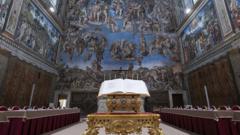The anticipation is high as 133 cardinals gather in Vatican City for the election of the next pope, beginning with a mass at St. Peter's Basilica. The event kicks off with a morning service, led by Cardinal Giovanni Battista Re, who officiated at Pope Francis' funeral. Anticipation builds as the cardinals will be secluded from the outside world, with mobile signals disabled in the Vatican territory early in the day.
Following the mass, the cardinals will make their way to the Sistine Chapel in a solemn procession, singing hymns, culminating in an oath of secrecy to keep the details of the papal elections confidential. The phrase “extra omnes” will signify the start of their isolation, ensuring the voting remains a closely guarded secret.
Once inside the chapel, the first round of voting will begin immediately, guided by Diego Ravelli, who will distribute ballot papers. Historically, the first vote has rarely resulted in a selection, with previous elections requiring multiple ballots to gauge support and achieve the necessary two-thirds majority.
Sources indicate that the cardinals will retire to a guesthouse for discussions if an immediate consensus isn't reached, where important talks could influence future votes. Rituals will include communal meals with a strictly regulated menu for the duration of the conclave, fostering both unity and secrecy among the electors.
As the days unfold, the focus will be on the chimney over St. Peter's Basilica, where thousands await the white smoke signal indicating a new pope has been appointed. This conclave is characterized not only by its solemnity but also the inherent unpredictability of the papal selection process. With differing opinions and aspirations within the church, the outcome remains uncertain, making this conclave a significant moment in Vatican history.
Following the mass, the cardinals will make their way to the Sistine Chapel in a solemn procession, singing hymns, culminating in an oath of secrecy to keep the details of the papal elections confidential. The phrase “extra omnes” will signify the start of their isolation, ensuring the voting remains a closely guarded secret.
Once inside the chapel, the first round of voting will begin immediately, guided by Diego Ravelli, who will distribute ballot papers. Historically, the first vote has rarely resulted in a selection, with previous elections requiring multiple ballots to gauge support and achieve the necessary two-thirds majority.
Sources indicate that the cardinals will retire to a guesthouse for discussions if an immediate consensus isn't reached, where important talks could influence future votes. Rituals will include communal meals with a strictly regulated menu for the duration of the conclave, fostering both unity and secrecy among the electors.
As the days unfold, the focus will be on the chimney over St. Peter's Basilica, where thousands await the white smoke signal indicating a new pope has been appointed. This conclave is characterized not only by its solemnity but also the inherent unpredictability of the papal selection process. With differing opinions and aspirations within the church, the outcome remains uncertain, making this conclave a significant moment in Vatican history.



















